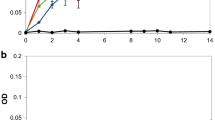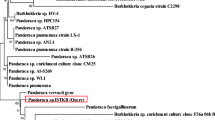Abstract
A kraft lignin-degrading bacterium (ITRC S 7 ) was isolated from sludge of pulp and paper mill and characterized as Aneurinibacillus aneurinilyticus by biochemical tests and 16SrRNA gene sequencing. The bacterium did not utilize kraft lignin (KL) as the sole source of carbon and energy. However, this strain reduced the color (58%) and lignin content (43%) from kraft lignin-mineral salt medium when supplemented with glucose at pH 7.6 and 30°C after 6 days. The degradation on addition of glucose in culture medium is clear evidence of co-metabolism of KL by A. aneurinilyticus. The analysis of lignin degradation products by GC-MS in ethyl acetate extract from an A. aneurinilyticus-inoculated sample revealed the formation of low molecular weight aromatic compounds such as guaiacol, acetoguaiacone, gallic acid and ferulic acid, indicating that the bacterium can oxidize of the sinapylic (G units) and coniferylic (S units) alcohol units which are the basic moieties that build the hardwood lignin structure. The low molecular weight aromatic compounds identified in extracts of the inoculated sample favors the idea of biochemical modification of the KL to a single aromatic unit.


Similar content being viewed by others
Abbreviations
- KL:
-
Kraft lignin
- MSM:
-
Mineral salt medium
- KL-MSM:
-
Kraft lignin amended mineral salt medium
References
Altschul SF, Madden TL, Schaffer AA, Zhang J, Zhang Z, Miller W, Lipman DJ (1997) Gapped BLAST and PSI-BLAST: a new generation of protein database search programs. Nucleic Acids Res 25:3389–3402
Amman R, Ludwig W, Schleifer K (1995) Phylogenetic identification and in situ detection of individual microbial cell without cultivation. Microbiol Rev 59:143–169
Bajpai P, Mehna A, Bajpai PK (1993) Decolorization of kraft bleach plant effluent with the white rot fungus Trametes versicolor. Process Biochem 28:377–384
Barrow GI, Feltham RKA (1993) Cowan and Steel’s manual for the identification of medical bacteria, 3rd edn. Cambridge University Press, Cambridge
Brosius J, Palmer ML, Kennedy PJ, Noller HF (1978) Complete nucleotide sequence of a 16S ribosomal RNA gene from Escherichia coli. Proc Nat Acad Sci USA 75:4801–4805
Chakar FS, Ragauskas AJ (2004) Review of current and future softwood kraft lignin process chemistry. Indust Crops Prod 20:131–141
Faulds CB, Bartolome B, Williamson G (1997) Novel biotransformations of agro-industrial cereal waste by ferulic acid esterases. Indust Crops Prod 6:367–374
Fiechter A (1982) Bioalteration of kraft pine lignin by Phanerochaete chrysosporium. Arch Microbiol 132:14–21
Forney LJ, Reddy CA (1979) Bacterial degradation of kraft lignin. Dev Indust Microbiol 20:163–175
Gonzalez B, Merino A, Almeida M, Vicna R (1986) Comparative growth of natural bacterial isolates on various lignin-related compounds. Appl Environ Microbiol 52:1428–1432
Graf E (1992) Antioxidant potential of ferulic acid. J Free Radic Biol Med 13:435–448
Gupta VK, Minocha AK, Jain N (2001) Batch and continuous studies on treatment of pulp mill wastewater by Aeromonas formicans. J Chem Technol Biotechnol 76:547–552
Hatakka A (1994) Lignin-modifying enzymes from selected white-rot fungi: production and role in lignin degradation. FEMS Microbiol Rev 13:125–135
Hedges JL, Ertel JR (1982) Characterization of lignin by gas capillary chromatography of cupric oxide oxidation products. Anal Chem 54:174–178
Hernandez M, Hernandez-Coronado MJ, Montiel MD, Rodriguez J, Arias ME (2001) Analysis of alkali-lignin in a paper mill effluent decolorised with two Streptomyces strains by gas chromatography-mass spectrometry after cupric oxide degradation. J Chromatogr A 919:389–394
Hernandez M, Rodriguez J, Perez MI, Ball AS, Arias ME (1997) 13C NMR cross polarization and magic angle spinning (CPMAS) and gas chromatography/mass spectroscopy analysis of the products from a soda pulp mill effluent decolorised with two Streptomyces strains. Appl Microbiol Biotechnol 74:272–278
Hernandez-Coronado MJ, Hernandez M, Rodriguez J, Arias ME (1998) Gas chromatography/mass spectrometry as a suitable alternative technique to evaluate the ability of Streptomyces to degrade lignin from lignocellulosic residues. Rapid Commun Mass Spectrom 12:1744–1748
Kapley A, Lampel K, Purohit HJ (2001) Development of Duplex PCR for Salmonella and Vibrio. World J Microbiol Biotechnol 16:457–58
Kern HW, Kirk TK 1987 Influence of molecular size and ligninase pretreatment on degradation of lignins by Xanthomonas sp. strain 99. Appl Microbiol Biotechnol 53:2242–2246
Ksibi M, Amor SB, Cherif S, Elaloui E, Houas A, Elaloui M (2003) Photodegradation of lignin from black liquor using UV/TiO2 system. J Photochem Photobiol A Chem 154:211–218
Lundquist K, Kirk TK (1971) Acid degradation of lignin. Acta Chem Scand 25:889–894
Masai E, Shinohara S, Hara H, Nishikawa S, Katayama Y, Fukuda M (1999) Genetic and biochemical characterization of a 2-pyrone-4, 6-dicarboxylic acid hydrolase involved in the protocatechuate 4,5-cleavage pathway of Sphingomonas paucimobilis SYK-6. J Bacteriol 181:55–62
Morii H, Nakamiya K, Kinoshita S (1995) Isolation of a lignin-decolorizing bacterium. J Ferment Bioeng 80:296–299
Narde G, Kapley A, Purohit HJ (2004) Isolation and characterization of Citrobacter strain HPC 255 for broad range substrate specificity for chlorophenol. Curr Microbiol 48:419–423
Perestelo F, Falcon MA, Carnicero A, Rodriguez A, de la Fuente G (1994) Limited degradation of industrial, synthetic and natural lignins by Serratia marcescens. Biotechnol Lett 16:299–302
Perestelo F, Falcon MA, Perez ML, Roig EC, de la Fuente Martin G (1989) Bioateration of kraft pine lignin by Bacillus megaterium isolated from compost piles. J Ferment Bioeng 68:151–153
Perestelo F, Rodriguez A, Perez R, Carnicero A, de la Fuente G, Falcon MA (1996) Isolation of a bacterium capable of limited degradation of industrial and labelled, natural and synthetic lignins. World J Microbiol Biotechnol 12:111–112
Pfennig N, Lippert KD (1966) Über das vitamin B-12-bedurbins phototropher schwefelbacterien. Arch Microbiol 55:245–256
Raj A, Chandra R (2004) Comparative analysis of physico-chemical and bacteriological parameters of kraft and pulp paper mill effluents. Indian J Environ Protect 24:481–489
Shin KS, Lee YJ (1999) Depolymerisation of lignosulfonate by peroxidase of the white-rot basidiomycete, Pleurotus ostreatus. Biotechnol Lett 21:585–588
Tien M, Kirk TK (1983) Lignin-degrading enzymes from himenomycete Phanerochaete chrysosporium Burds. Science 221:661–663
Trojanowski J, Haider K, Sundman V (1977) Decomposition of 14C-labelled lignin and phenols by a Nocardia sp. Arch Microbiol 114:149–153
Ulmer DC, Leisola MSA, Schmidt BH, Fiechter A (1983) Rapid degradation of isolated lignins by Phanerochaete chrysosporium. Appl Environ Microbiol 45:1795–1801
Vicuna R (1988) Bacterial degradation of lignin. Enzyme Microb Technol 10:646–655
Acknowledgements
The authors are grateful to Dr. C.M. Gupta, Director, Industrial Toxicology Research Centre, for encouragement and U.P-CST for providing financial assistance for this study. The authors are also thankful to Dr. Jai Raj Behari, Head, Analytical Chemistry Section for his suggestions in the characterization of lignin degradation products by GC-MS.
Author information
Authors and Affiliations
Corresponding author
Rights and permissions
About this article
Cite this article
Raj, A., Chandra, R., Reddy, M. et al. Biodegradation of kraft lignin by a newly isolated bacterial strain, Aneurinibacillus aneurinilyticus from the sludge of a pulp paper mill. World J Microbiol Biotechnol 23, 793–799 (2007). https://doi.org/10.1007/s11274-006-9299-x
Received:
Accepted:
Published:
Issue Date:
DOI: https://doi.org/10.1007/s11274-006-9299-x




